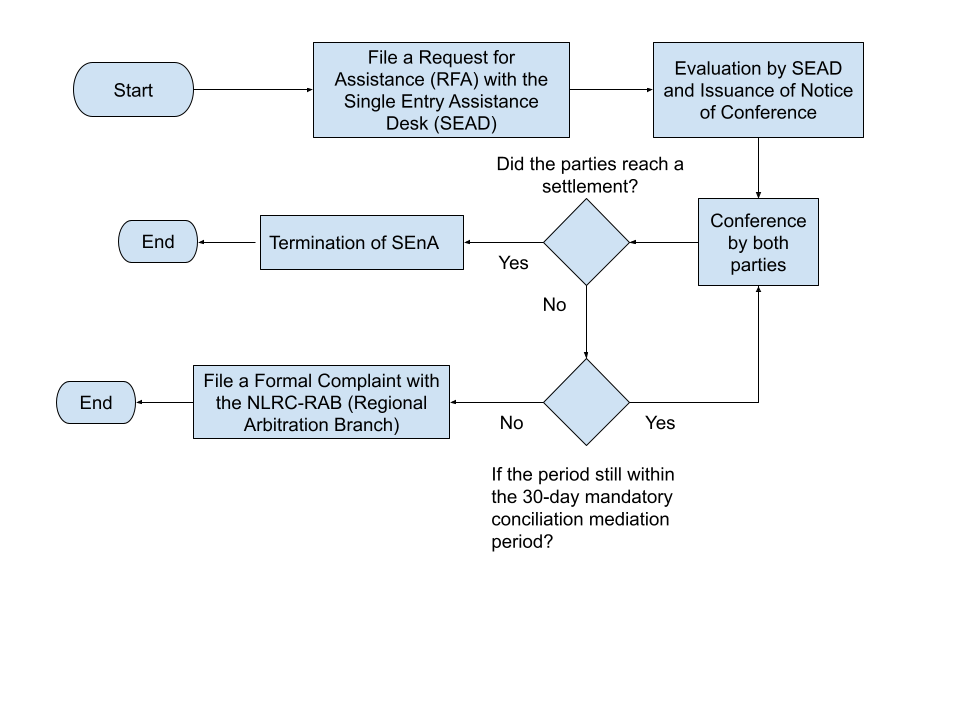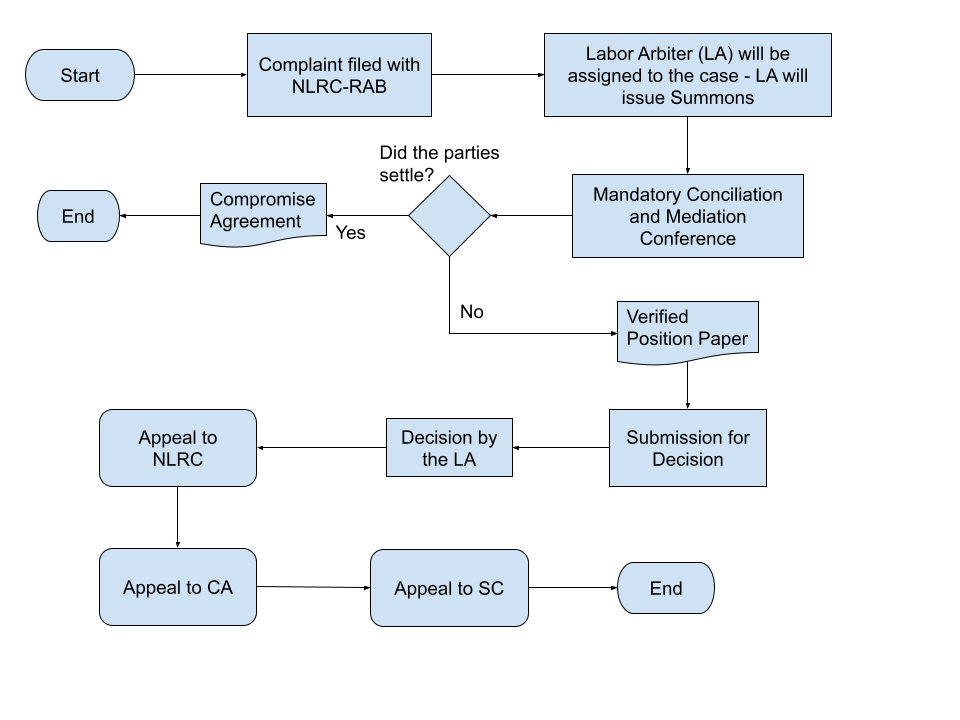
Table of Contents
How to file a Case at DOLE

The process of how to file a case at DOLE first starts at SenA and then may continue through to the Labor Arbitrar, NLRC Appeal and then the courts.
If you are filing or defending against a case for Illegal Dismissal, Constructive Dismissal or some other labor case, this article will help you understand the:
- The timeline and costs of filing a case at DOLE
- How to win an Illegal Dismissal case or check your grounds
- How to file a case at DOLE
- The possible percentage of winning the case at DOLE
What is the timeline and cost of filing a case at DOLE?
The timeline and cost of filing a case at DOLE increase substantially if position papers are filed and the case goes to Appeal.
The first part of the process at SEnA is basically free.

However, you will have to pay for:
- Service, where you send the employer the complaint
- Photocopying fees for the meetings
- Travel and coordination
However, it is the effort and time spent that can really cost you.
SEnA is a mediation process, so you will have to show up and present your side. The time spent traveling to the SEnA has to be considered. You will likely go at least 3 times.
If you do not appear the case will be dismissed.
If the SEnA fails, then the Labor Arbitrar is the next step.
The Labor Arbitrar will try to mediate between the employer and employee at this stage.
It is really good to consider a Compromise Agreement.
It may not contain everything but it is better to Compromise and move on with some award other than going through the Labor Arbitrar and the appeals at the NLRC and the courts.

If you are not able to settle, you are easily looking at 10 years to the Supreme Court and large expenses since Labor Lawyers can charge Php 5,000 or more per appearance (most charge more) and Php 7,000 per pleading/document.
And Position Papers themselves are not cheap. A Position Paper is a summary of your facts and evidence and takes hours and hours of a Labor Lawyer’s time to draft.
Because it is so important to get right – and so time-consuming – this is expensive, with some position papers starting at Php 50,000 and up at least.
These above costs exclude transportation, filing, photocopying, service, and other incidental costs.

Please note the above charges are just an illustration – it differs per location and expertise.
A Philippine Labor Lawyer with 14 years of experience in Metro Manila is more expensive than one with fewer years of experience.
But if you get a lawyer that doesn’t have the right expertise, you may end up losing the case.
So, if you can compromise, compromise.
How to win an Illegal Dismissal case in the Philippines (or Other Labor Case)
The first step to determine how to win an Illegal Dismissal case in the Philippines is to examine the evidence.

Say for example that you have decided that you are willing to spend at least several tens of thousands for your labor case.
Whether or not you have a chance of winning depends on the quality of your proof.
For example, an employee complained that her salary was being deducted for no reason.
I had to explain to her that these were valid month-end deductions for statutory benefits such as SSS, Pag-ibig and Philhealth.
I find that this happens a lot – an employee may not understand that there have to be specific reasons for his case to succeed.
And the evidence cannot be just what he said or felt but has to be proved.
You will only know if you have the right basis for a case if your lawyer goes through the evidence but of course actually having him assess all the emails, texts, chats, contracts as well as the 201 file takes hours and hours of work and so can be really expensive.
You can start off with a paid consultation with one of our Labor Lawyers to do a quick check to see if you have some basis for filing a case at DOLE.
What is the process of filing a Case at DOLE?
The process of filing a Labor Case at DOLE involves going through a SenA. Then, the case goes to the Labor Arbitrar, NLRC Appeal, the CA, and then the Supreme court.

Let’s go through the process.
Single Entry Approach: Part 1 of How to file a case at DOLE
The SEnA is the first part of how to file a case at DOLE.
The aggrieved employee must first start at SenA or the Single-Entry Approach before filing at DOLE.
SenA is a mandatory 30-day conciliation-mediation for issues regarding employer-employee relationships.

SEnA Flowchart
- A Request for Assistance (RFA) is filed at the SEAD (Single Entry Assistance Desk) in the regional office where the employer principally operates.
Also, an employee can file an RFA online through the e-SenA website.
- SEAD Evaluation
The employee/s shall be interviewed to assess the case.
The SEAD Officer (SEADO) shall immediately schedule the initial conference by issuing a Notice of Conference.
- SEADO Settlement
The SEADO may hold as many conferences as necessary so the parties can arrive at a settlement within the 30-day mandatory period.
- Termination of SenA
SenA terminates if the 30-day period ends or is pre-terminated or if a settlement has been reached and complied with.
Labor Arbitrar and Courts: Part 2 of How to file a case at DOLE

Labor Arbitrar and Court Process Flowchart
- If the parties fail to settle, the employee may file a formal complaint with the NLRC-RAB.
A Complaint will be filed with the Regional Arbitration Branch of the DOLE which has jurisdiction over the workplace of the complainant.
If two or more Regional Arbitration Branches have jurisdiction, the Branch that first acquired jurisdiction shall exclude the others.
- Labor Arbiter will handle the case after being raffled by the Executive Labor Arbiter and assigned to a Labor Arbiter.
- Labor Arbitrar issues Summons that specifies the date, time, and place of mandatory conciliation and mediation conference in two settings
- Mandatory conciliation and mediation conference is held to try to reach a Compromise Agreement.
If the complainant does not appear, the case can be dismissed without prejudice.
If the respondent does not appear, this shall be considered as a waiver of their right to file their respective position paper. The complainant can file their position paper and submit their evidence.

- The Labor Lawyers of the parties submit a verified position paper within 10 days from termination of the mandatory conciliation and mediation conference. Replies are possible.
- Labor Arbitrar may ask for a hearing or clarificatory conference
- Labor Arbitrar decides within thirty (30) days from submission of position papers or termination.
- If not appealed within 10 days of receiving the Decision, the Labor Arbitrar’s Decision becomes final.
- If appealed within 10 days of receiving the Decision, the case goes to the NLRC.
- NLRC appeal Fee: Php 110.00
- Timeline: 20 days for appeal from the decision of Labor Arbiter and POEA Administrator or 10 days for appeal from the decision of DOLE Regional Director
- Grounds: Abuse of discretion, serious errors in facts, questions of law, or if the decision was secured through fraud or coercion, including graft and corruption
- Appeal at the CA using Rule 65 or Special Civil Action for Certiorari based on the ground of grave abuse of discretion amounting to lack or excess of jurisdiction. Must be filed 60 days from notice.
- Appeal from the CA to the SC using Rule 45 or pure questions of law. Must be filed within 15 days from Notice
Likelihood of Winning a Labor Case in the Philippines: Statistics from DOLE

The latest 2021 Annual Report by the DOLE showed that 55% of the total cases were resolved in favor of labor at the Regional Arbitration Branches while 45% were in favor of management.
On appealed cases, 77% of the cases were resolved by the Commission proper in favor of labor while only 23% were resolved in favor of management.[1]
The tables below are from the 2014 to 2021 Annual Reports[2] by the DOLE illustrating the percentages of the disposition of cases in favor of labor and management.
Cases were usually resolved in favor of labor.
Though the NLRC resolved more cases in favor of management in 2011 until 2013, there is only a small difference in the percentages.
Table 1. Disposition of Cases at the Regional Arbitration Branches from 2011-2021
Year | Disposition of Cases in Favor of | ||||
Management | Percentage | Labor | Percentage | Total | |
2011 | 11,083 | 34.59 | 20,962 | 65.41 | 32,045 |
2012 | 10,968 | 35.51 | 19,920 | 64.49 | 30,888 |
2013 | 9,302 | 31.67 | 20,073 | 68.33 | 29,375 |
2014 | 10,222 | 32.30 | 21,427 | 67.70 | 31,649 |
2015 | 11,676 | 37.83 | 19,187 | 62.17 | 30,863 |
2016 | 10,785 | 35.31 | 19,759 | 64.69 | 30,544 |
2017 | 11,395 | 34.69 | 21,452 | 65.31 | 32,847 |
2018 | 9,816 | 26.50 | 27,221 | 73.50 | 37,037 |
2019 | 11,589 | 27.80 | 30,101 | 72.20 | 41,690 |
2020 | 8,359 | 39.46 | 12,822 | 60.54 | 21,181 |
2021 | 10,956 | 45.16 | 13,306 | 54.84 | 24,262 |
[1] 2021 Annual Report, https://nlrc.dole.gov.ph/uploads/content/2021%20Annual%20Report.pdf
[2] Retrieved from https://nlrc.dole.gov.ph/Node/view/TlYwMDAzMw
Table 2. Disposition of Cases at the Commission Proper from 2011-2021
Year | Disposition of Cases in Favor of | ||||
Management | Percentage | Labor | Percentage | Total | |
2011 | 5,972 | 50.54 | 5,845 | 49.46 | 11,817 |
2012 | 6,604 | 56.40 | 5,106 | 43.60 | 11,710 |
2013 | 5,558 | 50.18 | 5,518 | 49.82 | 11,076 |
2014 | 3,307 | 30.46 | 7,551 | 69.54 | 10,858 |
2015 | 3,676 | 33.36 | 7,343 | 66.64 | 11,019 |
2016 | 3,324 | 29.79 | 7,833 | 70.21 | 11,157 |
2017 | 3,349 | 42.37 | 4,555 | 57.63 | 7,904 |
2018 | 3,719 | 31.70 | 8,014 | 68.30 | 11,733 |
2019 | 3,219 | 27.75 | 8,383 | 72.25 | 11,602 |
2020 | 1,801 | 26.35 | 5,034 | 73.65 | 6,835 |
2021 | 1,868 | 22.86 | 6,303 | 77.14 | 8,171 |

